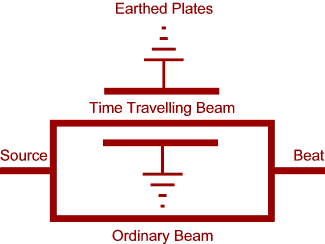
Here is an experiment that might measure fluctuations in time-flow. You probably think that time always flows forwards, but it is possible that time-flow oscillates backwards and forwards before time-duration increases by one step. This might happen if time-flow naturally oscillates, but random events occur. Truly random events cannot be reversed, so they force time-duration to increase.
It's a tricky idea, but it means that time has an internal structure. There is a continuously oscillating time-flow which is the fundamental kind of time, and then there is time-duration which is a side effect of random events that occur in steps. Whatever you think of this idea, it can be tested.
Surprisingly there is a machine which prevents some random events. It is called the Casimir apparatus and works by preventing virtual particles from popping into and out of existence. Particles cannot pop into existence unless they fit a whole number of times into the gap between two Earthed plates in a vacuum. If we could pass a beam of light between these plates it would experience fewer random events than a beam passing outside the plates. This means it would experience more time-flow oscillations and should get out of step with the ordinary beam. This phase shift should produce a beating pattern when the beams of light are brought back together again.

If this works, then the light beam between the plates has gone on a longer journey backwards and forwards in time than the ordinary beam. So it has transmitted a signal backwards and forwards in time. The ordinary beam interacts with the time traveling beam and we see the beat pattern in the present. So this apparatus is a time telephone.
If you want to talk on the phone, then speak into a microphone and have it vibrate the plates, or just wire the microphone up to the plates.
If this doesn't work, then time probably does not have an internal structure as hypothesised. Either way we would learn a lot from doing the experiment. That's the best sort of science. We get a useful result however the experiment turns out.
If you want to know more about this, read the Perspex Machine. If you still have any questions, call me up some time. I might already have answered you!
P.S. The simplest way to have two time telephones talk to each other is to use a beam of light like the string between two cans in a toy telephone. Make one time telephone, as above. This is the up stream telephone. Make another, but pass its beam through both telephones. This is the down stream telephone. If the experiment works, then modulating the upstream telephone modulates the down stream one, but at a later time, because the beam of light has had to pass in elapsed time from the upstream telephone to the down stream one. Of course, if the experiment does work then modulating the down stream telephone will modulate the upstream one at an earlier time. Hence two people can talk to each other across time.
If this really does work it will be extremely useful to be able to choose the best history for ourselves, but it has a down side. BT is going to find it very hard to work out a call charging tariff!